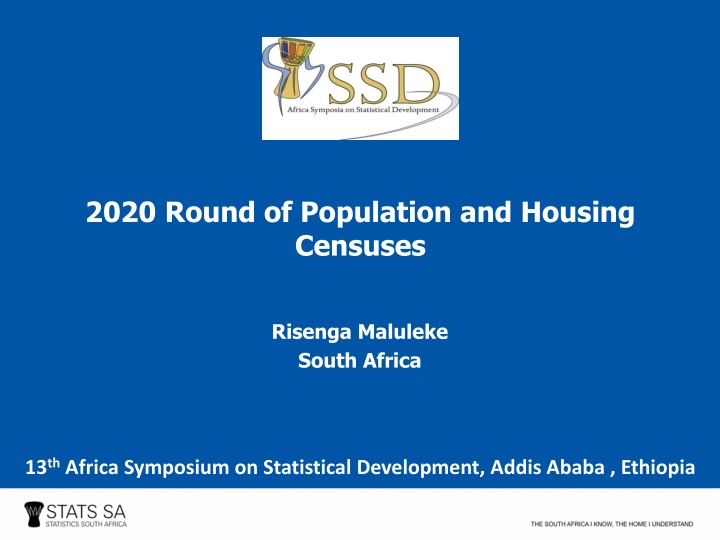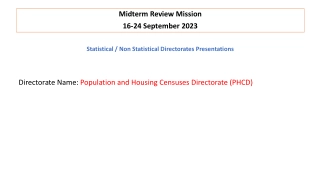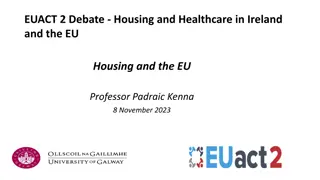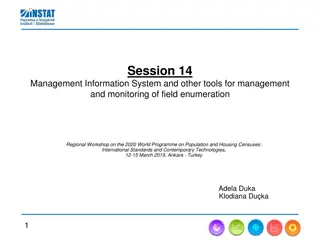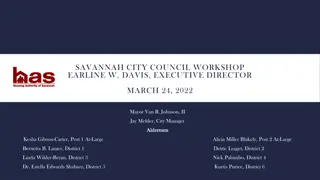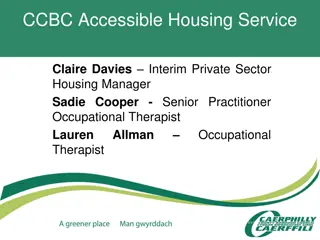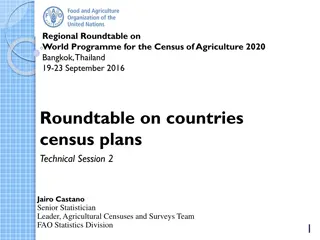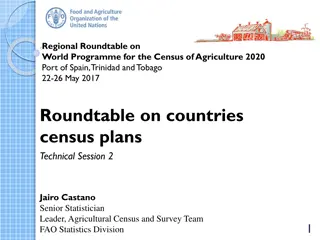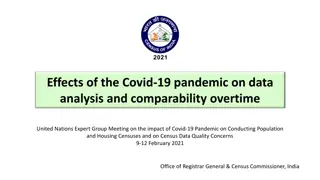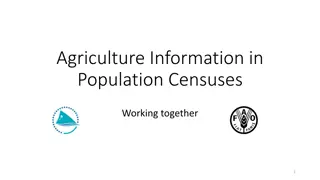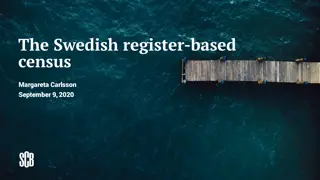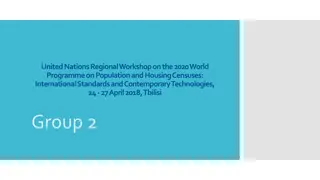2020 Round of Population and Housing Censuses in South Africa
The 2020 Round of Population and Housing Censuses in South Africa, as part of the 13th Africa Symposium on Statistical Development, focuses on the coordination of census activities among member states and the timely dissemination of census results to inform decisions for effective development planning and programs. The UN resolution emphasizes conducting census activities to ensure data accuracy for informed decision-making at national levels. Lessons learned from surveys in preparation for the 2021 Census are valuable for optimizing future census processes.
Uploaded on Feb 22, 2025 | 2 Views
Download Presentation

Please find below an Image/Link to download the presentation.
The content on the website is provided AS IS for your information and personal use only. It may not be sold, licensed, or shared on other websites without obtaining consent from the author.If you encounter any issues during the download, it is possible that the publisher has removed the file from their server.
You are allowed to download the files provided on this website for personal or commercial use, subject to the condition that they are used lawfully. All files are the property of their respective owners.
The content on the website is provided AS IS for your information and personal use only. It may not be sold, licensed, or shared on other websites without obtaining consent from the author.
E N D
Presentation Transcript
2020 Round of Population and Housing Censuses Risenga Maluleke South Africa 13th Africa Symposium on Statistical Development, Addis Ababa , Ethiopia
UN Conference New York, 2015 The UN Conference on Population and Housing censuses was held in 2015 in New York A resolution was taken on the 2020 World Population and Housing censuses. It recommends that all member states conducts at least one population and housing census during the 2020 round of censuses The 2020 round of censuses should take into account: International and regional recommendations relating to population and housing censuses and giving particular attention to advance planning, Cost efficiency, Coverage and the timely dissemination of, and easy access to, census results in order to inform decisions and facilitate the effective implementation of development plans and programmes.
UN Conference New York, 2015 The UN resolution coincides with the South African plan to conduct the Census in 2021 The purpose of conducting the 2020 round of population and housing censuses is to ensure the coordination of activities amongst the member states Statistics Act No. 6 of 1999 requires Statistics South Africa to conduct the population and housing census every 5 years Reason for Census 2021
Data Flow for CS2016 and KZN CSS HQ distributes the sample lists across teams of enumerators Interviewers visit households and collect data Content areas design questionnaires using visual tools and upload them to the central server (HQ) Interviewers synchronize their devices and upload completed questionnaires to Headquarters questionnaires without minimum acceptable criteria. Once accepted, the status is updated to Approved By supervisor, thereby playing the role of the role of the supervisor with respect to quality of completed questionnaires A script is executed on completed data at headquarters to autoreject Supervisors monitors and report on the Progress of the Fieldworkers Enumerators repeat interviews if errors were detected by auto reject script Questionnaires with all minimum required fields completed are automatically accepted by the headquarters
Lessons Learnt on Surveys in preparations for Census 2021 during the 2020 round of censuses
Census 2011 CS 2016 and KZN CSS SADHS 2015 PAPI- total count Creation of FW units 4questionnaires, loaded Conventional Use of tech: on PDAs/Tablets methodology (listing and o Geo-referenced DF Ratio 1 FWS per team enumeration) o Unpacking method (1 male, 1 female, 1 Self-enumeration was o Navigation logistics officer, 1 implemented in addition application loaded biomarker,1 publicity to the traditional data on the electronic officer) method (drop-off devices Assignment planning at system) o Assignment HO level to FWS; then CSAS system for planning at HO FWS to FW and back o Recruitment using the CAPI o Reporting system o Forward and reverse logistics
Census 2011 CS 2016 and KZN CSS SADHS 2015 Deployment of DCC QN easy to administer Sound plans were Structure ratio of QN was user-friendly with drawn with FWS/FW automated skip function. substantial inputs Call centre identify QN auto validations embedded to from geography. respondents who circumvent input errors by Substantial use was were not fieldworkers. made of geospatial enumerated MAR was successful in doing quality and other KYFC created checks technologies awareness in the OOS - FWSs received reports and public verified KTS for payment of The enforcement letters were used fieldstaff to get access in gated communities Field structure of and also assisted with the FWC-FWS-FW conversion of refusals
Census 2011 CS 2016 and KZN CSS SADHS 2015 Duration of listing very short System not picking up PSU Sample - delayed Not enough time to QA errors of multiple FW receipt of the sample listing using the same login from Methodology and Some areas did not follow details Standards to facilitate proper enumeration Searching of QN by way proper planning procedure during census of scrawl down from the Continuously changing night. workload leads to FW timelines led to QN A was not properly using the wrong QN frustrations and delays administered by FWs System lack of auto Lack of clear decisions more prevalent in assignment of QN in from management on a employment section where case of multiple HHs number of aspects skip instructions were not Navigating to a segment followed. FWU Extended enumeration Online recruitment a period due to non/late challenge especially on
Census 2011 CS 2016 SADHS 2015 Some areas did not follow System not picking up errors of Need to overcome proper enumeration multiple FW using the same the uncertainties procedure during census login details introduced by the night. Searching of QN by way of technology QN A was not properly scrawl down from the workload approach. administered by FWs leads to FW using the wrong Lack of consulting more prevalent in QN of subject matter employment section where System unduly rejecting specialists in the skip instructions were not completed QN for minimum Geography section followed. accessibility rule need in the early phases Extended enumeration thorough testing of project. period due to non/late The ratio of 1FWS:19FWs delivery of some materials Lack of OOS Verification Tool Access was deliberately (OOS) verification on the FWS denied app necessitating the FWS to
BACKGROUND [1/3] The Census 2021 project has adopted an ambitious approach, that of maximising on ICT innovations, on the back of an improved GIF hence Digital 2021 Census This aligns to the recently initiated Digital Transformation concept paper The recent technological breaches of security at reputable organisations are a constant reminders for us to ensure that confidentiality of personal information is guaranteed as stipulated in the Stats Act 6 of 1999 The United Nations Statistical Division (UNSD) has produced Guidelines on the use of electronic data collection technologies in population and housing censuses
BACKGROUND [2/3] The guidelines emphasise amongst other things the following: A sound decision-making process for understanding the value of introducing a particular technology solution, evaluating its cost-effectiveness and viability on the basis of key institutional, operational and social factors, and making such a decision on the basis of the information gathered during this process Geospatial information and systems to integrate the census mapping, enumeration and data analysis phases as well as for improving the efficiency and effectiveness of field work operations Effective security for IT systems and electronic data to prevent inappropriate disclosure of sensitive information and disruptions in critical operations
BACKGROUND [3/3] To create a credible census plan, anchored by continuous testing of these plans We need to create adequate confidence internally and externally before the Census 2021 Pilot, that most changes we are introducing can handle the expected volumes, while not compromising on the quality of the statistical output Therefore collaborative effort at various levels of society is key and setting up of structures and their terms of reference All these should be well clarified in planning documents; the strategy; operational plans; project templates; etc.
BACKGROUND [3/3] To update a GIF consisting of the Dwelling Frame, EA and Place Names datasets To create datasets to support the HR Recruitment tool To develop a Navigation application To develop a GIF Update application
KEY MILESTONES FINANCIAL YEAR 2018/2019 Activities Internal stakeholder workshop 1 New methodology test Internal stakeholder workshop 2 Timelines March 2018 September 2018 October 2018 October 2018 February 2019 March 2019 March 2019 Provincial workshops User consultations Questionnaire and developments Completion of all plans March 2019 Specifications for the Materials (Mini Test) Geography GIF updates Community mobilization and advocacy March 2019 March 2019
FINANCIAL YEAR 2019/2020 Mini Test Activities System requirements and specifications Timelines May 2019 May 2019 Procurement (Mini Test) July 2019 System development July 2019 August 2019 Infrastructure assessment Recruitment and appointment September 2019 Training October 2019 Integrated test (Data collection) November 2019 Payment December 2019 March 2020 March 2020 March 2020 Specifications for Materials (Pilot) Debriefing Community mobilization and advocacy Geography GIF updates
FINANCIAL YEAR 2020/2021 Pilot Activities Instruments and systems update (System Review) Procurement (Pilot) Recruitment and appointment Forward logistics Training Data collection Payment Reverse logistics Secondary editing and imputation Analysis Debriefing and closure report Final Specifications for Materials (Main) System review Geography GIF updates Timelines May 2020 July 2020 August 2020 August 2020 September 2020 October 2020 November 2020 November 2020 November 2021 December 2020 December 2020 December 2020 March 2021 March 2021
FINANCIAL YEAR 2021/2022 Main Census Activities Community mobilization and advocacy National workshop Training Timelines Mar 2021 August 2021 September 2021 August 2021 May 2021 August 2021 June 2021 October 2021 November 2021 November 2021 December 2021 December 2021 December 2021 December 2021 Recruitment and appointment Procurement Forward logistics Geography GIF updates Data collection Payment PES Secondary editing and imputation Secondary editing and imputation (PES) Analysis Debriefing
FINANCIAL YEAR 2022/2023 Activities Timelines June 2022 Dissemination September 2022 Closure report March 2023 Community mobilization and advocacy
